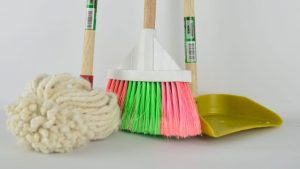This post was last updated on August 12, 2021 by Preethi Sukumaran
If it is too good to be true, then it probably is. Krya was conducting a workshop and showcasing skin care products at the Alternative’s Green Bazaar yesterday. We commissioned a commercial artist to hand paint a cloth banner for us for our stall. We wanted to avoid the regular plastic flex banners with digital prints. We e-mailed our artwork to the artist, who assured us a perfect reproduction of the design by his own hand, using cloth and paint.
We were getting the banner printed in a rush , just the day before the bazaar. The night before the event we hopped into the artist’s studio to check out the progress on our banner. We arrived in time to discover that he digitally printed our design on a piece of flex and was using that as a stencil to create a “hand-painted” sign.
So after all the fuss, we printed a plastic banner in order to create a sustainable, hand-painted cloth banner. Had we known this, we could stopped our artist right at the plastic stage.
So we took our resource heavy cloth banner to the Green Bazaar on Sunday morning, along with the Krya detergent and Dishwash and the preview packs of the soon to be launched Krya hair wash and Krya face wash.

Conversations on Sustainable Menstruation
We were thrilled to meet the team from Eco Femme, which is doing great work in sustainable menstruation. Kathy of Eco-Femme introduced me to Vijay and his work in menstrual activism. Vijay’s work is in a very specific field in menstruation: the right to sun-dry your undergarments and menstrual cloth. Before you think that this is a little too specific, Vijay shared a study by the Adyar cancer Institute which found that one of the causes of cervical cancer was the lack of sun drying of undergarments and menstrual cloth. The subsequent dampness, moisture and folding away of these garments were somehow able to create favourable conditions for the entry and spread of the Human Papilloma virus, which is associated with several medical conditions including cervical cancer.
I was struck how some people don’t have the basic to right to dry their clothes in the sun and some-how ended up with terrible consequences. This was an eye-opener.

Later in the day, I was happy to share my experiences with Menstruation and how I made the switch to Eco Femme’s earth friendly cloth pads at Eco Femme’s Sustainable menstruation workshop. Kathy Walking then showed us a very powerful video that they had made at Auroville to demonstrate both current menstrual practices and the environmental effect of continuing to use disposable products. This video showed that women across India tried to dry their undergarments and menstrual cloth in cupboards, under beds, in the bathrooms, under sinks and similarly damp, possibly unhygienic places which had no air or light. This arose from a superstition that menstrual cloth was unlucky and should not be seen by Men. The point that Vijay was making resonated strongly with me as I saw this.
The second piece of research estimated the size of landfill if every single woman in India used disposable menstrual napkins every year–58 billion pads thrown away each year would occupy the land equivalent to 173 football fields every single year!
So yes, it is important to be open about Menstruation, and claim both our right to sun dry and our right to make better choices for our planet.
The Sustainable Fabric workshop
Krya and Chakra design studio jointly hosted a workshop on handlooms and naturally dyed fabric. A conversation with Ananthoo of Tula, reveals an interesting economic fact – a kilo of chemical dye costs as low as Rs 20, and a kilo of vegetable dye could cost anywhere between Rs 400 – Rs 1000 !

So obviously on the face of it, it makes no economic sense to even attempt to use natural dye on your fabric. Plus the colour palette of natural dyes is extremely limited. You will not obtain the “exciting” computer colours that are not abundantly present in nature like lime green or fuchsia or a bright purple.

The Krya Chakra workshop was an introduction to handlooms and natural dyes, and listening to Bindu, I was struck by other limitations of the craft. The natural dyeing process is temperamental – you are never sure of the exact shade of colour you will get at the end of the process, because the same tree across different harvest years will yield slightly different shades.
The natural dyeing process needs to be done very carefully and meticulously. For example, to ensure the cloth holds the dye, dyers use different pre-treatment methods like soaking the plain fabric in buffalo milk and Terminalia chebulia or Myrobalan before applying the mordant. And this varies from region to region and the natural resources that are available to each dyeing community.
Natural dyeing is also a very water intensive process, compared to chemical dyeing. Chemical dyes come in easy to use forms which can then be straight away applied to the cloth, and have been designed to be colour fast.
But applying natural colours follows a linear process: each colour has to be applied, fixed, the excess washed off and sun dried before the next colour can make its way into the fabric. The process is therefore very time-consuming compared to using chemical dyes.
With so many apparent disadvantages in using natural dyes, why then are we supporting this craft?
While the water consumed by natural dyeing is large, it is important to remember that all of this water can be happily used for agriculture or other purposes. Bindu shares that in her dyeing village, the craftsmen swim in the irrigation canal, and stand of either side of it allowing the flowing water to wash away any excess dye. The farmers who use this water are happy to share it as they believe this water is good for the crops and does not harm in any way.
We must remember that before our centralised factory based models came into being, our lives were more intertwined and symbiotic. Treatises on the fabric traditions of India reveal a system of barter used to exist: cotton farmers would exchange their cotton with spinners for finished yarn which they could then hand weave themselves. Spinners would also barter yarn with weavers for finished fabric.
Chemical dyeing today has its roots in natural plant based dyeing, and the craftsmen are drawn from the communities of vegetable dyers. And they carry along with them practices of vegetable dyeing. So while chemical dyeing does not require the extensive rinsing and drying and liner processing that vegetable dyeing entails, it still requires water as a last rinse. And both small chemical dyers and large dyeing factories dip their textiles into running water and rivers to rinse off the excess dye.
The aftermath of chemical dyeing
We already shared the story of the Noyyal River in Tiruppur. Historically, the Noyyal River was called the “Kanchinadi” and considered a sacred river. The river itself is said to contain minerals which are health giving and considered “antibiotic” in nature.
The Chalukya Chola Kings built an interconnected tank and canal system to this river which helped drain away the excess water from the river into an intricate system of tanks preventing flooding along the banks. And the tanks themselves helped replenish groundwater by percolating the sub soil (in this we must understand that these tanks were not the impermeable cement graves that we dig today in the name of water storage, but tanks where the bottom was mud allowing water to percolate the sub soil).
Today, the Noyyal River has been kindly described as a sewer. The Tamilnadu Pollution control board estimates conservatively that 883,000 tonnes of toxic waste is dumped into the Noyyal River every year by the textile mills around Tiruppur.

Farmers have abandoned cultivation as digging below 6 feet releases a black, toxic sludge. Any produce grown absorbs chemical content and changes colour – coconuts for instance were found to have red insides as against their regular white insides.

Chemical dyeing related illnesses
A video from Craft mark which documents the process of hand dyeing using chemical dyes, reveals a horrific basket of chemicals which the dyers dip their hands into every month – to set the dyes, the dyers have to dip their hands and the fabric into caustic soda, hydrochloric acid, sodium nitrate and soda ash, and acetic acid. The dye stains their skin almost indelibly and they find eating difficult as the dye colours and odorises the food they eat. They explain that they need to take a 2 day holiday to recover for every 10 day chemical dyeing work they do.
As we shared this with the audience at the Sustainable fabric workshop, we saw several people look at their shirts and garments with undisguised horror – imagine the effect these very same chemicals will have as they sit malignantly close to your skin and continue to be slowly absorbed by your skin every day.
Krya Talk
Of course, apart from the conversations with different people and the workshops at the Bazaar, it is a very edifying experience to stand in your own stall and greet visitors with information about what you do. I found a lot of interest around the Krya hair wash, and our small batch at the Bazaar was sold out. Apparently even my threats of greenish residue left behind in the hair was not enough to deter people who wanted to try out a safer product on themselves. The question I was asked most about was whether the Hair wash would reverse hair fall.

I am particularly wary about marketing claims, coming as I do from a background in Consumer Product Marketing. Most research and statistics can be interpreted in any way to obtain favourable results for the product you are marketing.
I particularly dislike product claims – it is my belief that is almost impossible to isolate external, environmental and internal causes from the workings of a product. So if I told you the Krya hair wash would reduce hair fall, and when you bought the product, you also decided to detox your life and started eating organic food that was wholegrain and maybe vegan, with a lot of greens in your diet, it would stand to reason that your health indices would dramatically improve. This meant that your hair fall, if you had any would also slow down. Now should I attribute it to the Krya hairwash you were using at the time? Knowing what goes into the product and how it works, I could say yes. But I would be incorrect if I discounted the dramatic effect of eating clean healthy food on your system.
So to the questions on hair loss, I simply said that the hair wash would do what it was supposed to do really well – it would clean your scalp and hair without loading your system with toxins, and leave your scalp to function in a regular healthy manner without irritating it or stripping it of serum.
I was pleased to find that my underplayed response resonated with my audience. And we quickly sold out. To add to this, 2 of my consumers who had bought the hair wash two weeks back when we launched, came to the stall to tell me how well the product was working for them. And this feedback, as you know, makes my heart sing. If you too would like to try our limited range of skin and hair care goodies please click here.
The Green Bazaar also showcased some interesting food stalls, including a food stall by SHARAN which showcased vegan food and also showcased the vegan creations of a young Mum who is a wholegrain baker. I noticed several participants carrying SHARAN’s leaflets, and was thrilled at people’s interest and curiosity around this very pertinent subject.


In case you missed it, the Alternative’s Green Bazaar is a bi-monthly event – so do ensure you are there the next time around.
If you too would like to know about Menstruation and why it is not environmentally sustainable at the moment and explore your options, start here.
In the meantime, our series on sustainable fabric continues. Our series on sustainable fabric has the following posts:
- Our introductory post on the sustainable fabric series
- On the One Person Satyagraha and why you should start one
- On the environmental and human health hazards of chemical dyes
- The primer to sustainable Indian fabric is here
- The first part of the textile traditions of India that suit Spring and Summer is here
- The second part of the textile traditions of India that suit Monsoons and Winter is here.
- Our post interviewing Lata Ganapathy-Ravikiran on Handloom love and why she chooses to support this industry is here.
- Our post on the warped state of Handlooms in India and what ails the sector is here.
- Our post on the dangers and all pervasiveness of Bt Cotton is here .
- Our post on Onam, the Mundum neriyathum and wearing your culture is here.




